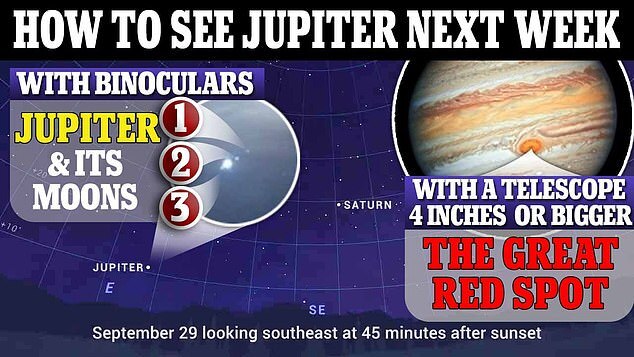Stargazers, look up! Jupiter to make closest approach to Earth in 59 years on Monday for 'extraordinary' views - even though it's 367M miles away
- Jupiter will reach its closest approach to Earth since 1963 on Monday night
- The planet will be 367 million miles from us at the closest point
- The gigantic planet will be rising in the east as the sun sets in the west - putting Jupiter and the sun on opposite sides of Earth
- 'With good binoculars, the banding (at least the central band) and three or four of the Galilean satellites (moons) should be visible,' a NASA scientist says
By CHRISTOPHER CARBONE U.S. SCIENCE AND TECHNOLOGY EDITOR FOR DAILYMAIL.COM
PUBLISHED: 06:00 AEST, 21 September 2022 | UPDATED: 07:03 AEST, 21 September 2022
Stargazers are in for quite a treat when Jupiter reaches its closest approach to Earth since 1963 on Monday evening.
The giant planet, which will be 367 million miles from us at the closest point, is reaching its opposition next week. That simply means the planet will be rising in the east as the sun sets in the west - putting Jupiter and the sun on opposite sides of Earth.
The massive planet is about 600 million miles away from Earth at its farthest point. Although Jupiter's opposition takes place every 13 months, this one is unique.

Stargazers are in for quite a show when Jupiter reaches its closest approach to Earth since 1963 on Monday evening. Above: This photo of Jupiter, taken from the Hubble Space Telescope on June 27, 2019, features the Great Red Spot, a storm the size of Earth that has been raging for hundreds of years
That's because Earth and Jupiter do not orbit the Sun in perfect circles – meaning they pass each other at different distances throughout the year.
Jupiter’s closest approach to Earth hardly ever coincides with opposition, which means this year’s views will be 'extraordinary,' according to NASA.
Although Jupiter is one of the few planets that can be seen with naked eyes, NASA still recommends using some type of instrument.
'With good binoculars, the banding (at least the central band) and three or four of the Galilean satellites (moons) should be visible,' Adam Kobelski, a research astrophysicist at NASA’s Marshall Space Flight Center in Huntsville, Alabama, said in a statement.

The giant planet, which will be 367 million miles from us at the closest point, is reaching its opposition next week. NASA recommends a pair of binoculars or a 4-inch telescope for the best views

'The views should be great for a few days before and after Sept. 26,' Kobelski explained. 'So, take advantage of good weather on either side of this date to take in the sight. Outside of the Moon, it should be one of the (if not the) brightest objects in the night sky.' Above: As the Moon rose over the Wasatch Mountains near Salt Lake City on Feb. 27, 2019, the planet Jupiter could be seen, along with three of its largest moons
'It’s important to remember that Galileo observed these moons with 17th century optics. One of the key needs will be a stable mount for whatever system you use.'
A 4-inch or larger telescope would allow observers to see Jupiter's Great Red Spot and bands in more detail.
Kobelski said an ideal viewing spot would be at a high elevation in a dark and dry area.
'The views should be great for a few days before and after Sept. 26,' Kobelski explained. 'So, take advantage of good weather on either side of this date to take in the sight. Outside of the Moon, it should be one of the (if not the) brightest objects in the night sky.'
The U.S. space agency notes that Jupiter has no fewer than 53 named moons, out of 79 that are believed to have been detected in total, including the four largest ones: Io, Europa, Ganymede and Callisto.
NASA's Juno spacecraft has been orbiting Jupiter for six years - providing scientists with images and data of the gigantic planet's atmosphere, structures and magnetic field since then.
Juno's mission was recently extended to 2025 or the end of the spacecraft's life.
The Europa Clipper, a spacecraft that will explore Jupiter's moon that's known for its icy shell and vast ocean, is set to launch in October 2024 and would arrive at Jupiter in April 2030.
Share or comment on this article:
Look up! Jupiter to make closest approach to Earth in 59 years on Monday for 'extraordinary' views